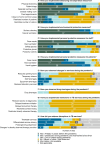The long-term impact of the COVID-19 pandemic on tuberculosis care and infection control measures in anti-retroviral therapy (ART) clinics in low- and middle-income countries: a multiregional site survey in Asia and Africa
- PMID: 40127942
- PMCID: PMC11934364
- DOI: 10.1136/bmjgh-2024-017828
The long-term impact of the COVID-19 pandemic on tuberculosis care and infection control measures in anti-retroviral therapy (ART) clinics in low- and middle-income countries: a multiregional site survey in Asia and Africa
Abstract
Background: The COVID-19 pandemic challenged healthcare systems, particularly in settings with high infectious disease burden. We examined the postpandemic long-term impacts of COVID-19 on tuberculosis (TB) services at anti-retroviral therapy (ART) clinics in lower-income countries.
Methods: Using standardised online questionnaires, we conducted a cross-sectional site survey among ART clinics providing TB services in Africa and Asia from July to September 2023 (site-level information and number of TB diagnoses and tests).
Results: Of 45 participating ART clinics, 32 (71%) were in Africa and 13 (29%) in Asia. During the COVID-19 pandemic (2020-2022), 43 (96%) clinics reported implementing social distancing or separation measures, 39 (87%) personal protections for staff members and 32 (71%) protections for patients. Infection control measures were in place in 45% of the clinics before the pandemic (until 2019), 23% introduced measures during the pandemic and 15% maintained them after the pandemic (after 2022). Service provision was affected during the pandemic in 33 (73%) clinics, including TB services in 22 (49%) clinics. TB service restrictions were addressed by introducing changes in directly observed therapy provision in 8 (18%) clinics, multimonth TB drug dispensing in 23 (51%), telehealth services in 25 (56%) and differentiated service delivery in 19 (42%). These changes were sustained after the pandemic at 4 (9%), 11 (24%), 17 (38%) and 12 (27%) clinics, respectively. Compared with 2018-2019, the number of TB diagnoses decreased sharply in 2020-2021 and improved after the pandemic.
Conclusions: COVID-19 affected TB care services in ART clinics in Africa and Asia. This was paralleled by a reduction in TB diagnoses, which partly resumed after the pandemic. Infection control measures and alternative modes of service delivery were adopted during the pandemic and only partially maintained. Efforts should be made to sustain the lessons learnt during the COVID-19 pandemic, particularly approaches that reduce the risk of transmission of infectious diseases, including TB, in ART clinics.
Keywords: COVID-19; HIV; Tuberculosis.
© Author(s) (or their employer(s)) 2025. Re-use permitted under CC BY-NC. No commercial re-use. See rights and permissions. Published by BMJ Group.
Conflict of interest statement
Competing interests: None declared.
Figures



References
-
- World Health Organization Global tuberculosis report 2023. 2023. [29-Apr-2024]. https://www.who.int/teams/global-tuberculosis-programme/tb-reports/globa... Available. Accessed.
MeSH terms
Substances
Grants and funding
LinkOut - more resources
Full Text Sources
Medical
